Delineating Urban Community Life Circles for Large Chinese Cities Based on Mobile Phone Data and POI Data—The Case of Wuhan
Abstract
1. Introduction
2. Literature Review
3. Methodology and Materials
3.1. Methodological Framework
3.1.1. Establishing the OD Relationship of Residents’ Daily Activities
3.1.2. Inferring the Travel Paths and Frequency of Residents’ Activities
3.2. Study Area
3.3. Data Sources and Preprocessing
3.3.1. Mobile Phone Data
3.3.2. POI Data
3.3.3. Data Preprocessing
3.4. Application of the Methodological Framework
4. Results
4.1. The Coverage of the CLCs
4.2. The Daily Travel Pattens of Residents
5. Discussions
5.1. Community Life Circle Is Not a Homogeneous Circle
5.2. The Coverages of the Adjacent CLCs Are Shared
5.3. Residents’ Different Travel Tendencies for Different Types of Facilities
5.4. Applicability of the DMP Method
5.5. Limitations and the Future Work
6. Conclusions
Author Contributions
Funding
Conflicts of Interest
References
- Burton, C.G. A Validation of Metrics for Community Resilience to Natural Hazards and Disasters Using the Recovery from Hurricane Katrina as a Case Study. Ann. Assoc. Am. Geogr. 2015, 105, 67–86. [Google Scholar] [CrossRef]
- Gilmore, B.; Ndejjo, R.; Tchetchia, A.; de Claro, V.; Mago, E.; Diallo, A.A.; Lopes, C.; Bhattacharyya, S. Community Engagement for COVID-19 Prevention and Control: A Rapid Evidence Synthesis. BMJ Glob. Health 2020, 5, e003188. [Google Scholar] [CrossRef] [PubMed]
- Lee, T.H. Influence Analysis of Community Resident Support for Sustainable Tourism Development. Tour. Manag. 2013, 34, 37–46. [Google Scholar] [CrossRef]
- Zuo, J.; Meng, L.; Li, C.; Zhang, H.; Zeng, Y.; Dong, J. Construction of Community Life Circle Database Based on High-Resolution Remote Sensing Technology and Multi-Source Data Fusion. Eur. J. Remote Sens. 2021, 54, 222–237. [Google Scholar] [CrossRef]
- Li, C.; Xia, W.; Chai, Y. Delineation of an Urban Community Life Circle Based on a Machine-Learning Estimation of Spatiotemporal Behavioral Demand. Chin. Geogr. Sci. 2021, 31, 27–40. [Google Scholar] [CrossRef]
- Befu, H. Lives in Motion: Composing Circles of Self and Community in Japan. J. Jpn. Stud. 2001, 27, 477–481. [Google Scholar] [CrossRef]
- Moreno, C.; Allam, Z.; Chabaud, D.; Gall, C.; Pratlong, F. Introducing the “15-Minute City”: Sustainability, Resilience and Place Identity in Future Post-Pandemic Cities. Smart Cities 2021, 4, 93–111. [Google Scholar] [CrossRef]
- Wu, H.; Wang, L.; Zhang, Z.; Gao, J. Analysis and Optimization of 15-Minute Community Life Circle Based on Supply and Demand Matching: A Case Study of Shanghai. PLoS ONE 2021, 16, e0256904. [Google Scholar] [CrossRef]
- Roux, A.V.D. Investigating Neighborhood and Area Effects on Health. Am. J. Public Health 2001, 91, 1783–1789. [Google Scholar] [CrossRef]
- Foth, N.; Manaugh, K.; El-Geneidy, A.M. Towards Equitable Transit: Examining Transit Accessibility and Social Need in Toronto, Canada, 1996–2006. J. Transp. Geogr. 2013, 29, 1–10. [Google Scholar] [CrossRef]
- Liu, T.; Chai, Y. Daily Life Circle Reconstruction: A Scheme for Sustainable Development in Urban China. Habitat Int. 2015, 50, 250–260. [Google Scholar] [CrossRef]
- Wan, J.; Zhao, Y.; Zhang, K.; Ma, C.; Sun, H.; Wang, Z.; Wu, H.; Li, M.; Zhang, L.; Tang, X.; et al. Healthy Community-Life Circle Planning Combining Objective Measurement and Subjective Evaluation: Theoretical and Empirical Research. Int. J. Environ. Res. Public Health 2022, 19, 5028. [Google Scholar] [CrossRef] [PubMed]
- Tian, Y.; Kong, X.; Liu, Y. Combining Weighted Daily Life Circles and Land Suitability for Rural Settlement Reconstruction. Habitat Int. 2018, 76, 1–9. [Google Scholar] [CrossRef]
- Song, Y.; Huang, B.; Cai, J.; Chen, B. Dynamic Assessments of Population Exposure to Urban Greenspace Using Multi-Source Big Data. Sci. Total Environ. 2018, 634, 1315–1325. [Google Scholar] [CrossRef] [PubMed]
- Martí, P.; Serrano-Estrada, L.; Nolasco-Cirugeda, A. Social Media Data: Challenges, Opportunities and Limitations in Urban Studies. Comput. Environ. Urban Syst. 2019, 74, 161–174. [Google Scholar] [CrossRef]
- Song, Y.; Huang, B.; He, Q.; Chen, B.; Wei, J.; Mahmood, R. Dynamic Assessment of PM2.5 Exposure and Health Risk Using Remote Sensing and Geo-Spatial Big Data. Environ. Pollut. 2019, 253, 288–296. [Google Scholar] [CrossRef]
- Bao, J.; Zheng, Y.; Wilkie, D.; Mokbel, M. Recommendations in Location-Based Social Networks: A Survey. Geoinformatica 2015, 19, 525–565. [Google Scholar] [CrossRef]
- Long, Y.; Thill, J.-C. Combining Smart Card Data and Household Travel Survey to Analyze Jobs-Housing Relationships in Beijing. Comput. Environ. Urban Syst. 2015, 53, 19–35. [Google Scholar] [CrossRef]
- Wang, Z.; He, S.Y.; Leung, Y. Applying Mobile Phone Data to Travel Behaviour Research: A Literature Review. Travel Behav. Soc. 2018, 11, 141–155. [Google Scholar] [CrossRef]
- Yue, Y.; Lan, T.; Yeh, A.G.O.; Li, Q.-Q. Zooming into Individuals to Understand the Collective: A Review of Trajectory-Based Travel Behaviour Studies. Travel Behav. Soc. 2014, 1, 69–78. [Google Scholar] [CrossRef]
- Wesolowski, A.; Stresman, G.; Eagle, N.; Stevenson, J.; Owaga, C.; Marube, E.; Bousema, T.; Drakeley, C.; Cox, J.; Buckee, C.O. Quantifying Travel Behavior for Infectious Disease Research: A Comparison of Data from Surveys and Mobile Phones. Sci. Rep. 2014, 4, 5678. [Google Scholar] [CrossRef] [PubMed]
- Ratti, C.; Frenchman, D.; Pulselli, R.M.; Williams, S. Mobile Landscapes: Using Location Data from Cell Phones for Urban Analysis. Environ. Plan. B Plan. Des. 2006, 33, 727–748. [Google Scholar] [CrossRef]
- Zhao, Z.; Shaw, S.L.; Xu, Y.; Lu, F.; Chen, J.; Yin, L. Understanding the Bias of Call Detail Records in Human Mobility Research. Int. J. Geogr. Inf. Sci. 2016, 30, 1738–1762. [Google Scholar] [CrossRef]
- González, M.C.; Hidalgo, C.A.; Barabási, A.L. Understanding Individual Human Mobility Patterns. Nature 2008, 453, 779–782. [Google Scholar] [CrossRef]
- Song, C.; Qu, Z.; Blumm, N.; Barabási, A.L. Limits of Predictability in Human Mobility. Science 2010, 327, 1018–1021. [Google Scholar] [CrossRef]
- Calabrese, F.; Ferrari, L.; Blondel, V.D. Urban Sensing Using Mobile Phone Network Data: A Survey of Research. ACM Comput. Surv. 2014, 47, 1–20. [Google Scholar] [CrossRef]
- Jones, K.H.; Daniels, H.; Heys, S.; Ford, D.V. Challenges and Potential Opportunities of Mobile Phone Call Detail Records in Health Research: Review. JMIR mHealth uHealth 2018, 6, e161. [Google Scholar] [CrossRef]
- Zilske, M.; Nagel, K. Studying the Accuracy of Demand Generation from Mobile Phone Trajectories with Synthetic Data. In Procedia Computer Science, Proceedings of the 5th International Conference on Ambient Systems, Networks and Technologies (Ant-2014), the 4th International Conference on Sustainable Energy Information Technology (Seit-2014), Hasselt, Belgium, 2–5 June 2014; Shakshuki, E., Yasar, A., Eds.; Elsevier Science Bv: Amsterdam, The Netherlands, 2014; Volume 32, pp. 802–807. [Google Scholar]
- Diao, M.; Zhu, Y.; Ferreira, J.; Ratti, C. Inferring Individual Daily Activities from Mobile Phone Traces: A Boston Example. Environ. Plan. B-Plan. Des. 2016, 43, 920–940. [Google Scholar] [CrossRef]
- Xiong, Q.; Liu, Y.; Xie, P.; Wang, Y.; Liu, Y. Revealing Correlation Patterns of Individual Location Activity Motifs between Workdays and Day-Offs Using Massive Mobile Phone Data. Comput. Environ. Urban Syst. 2021, 89, 101682. [Google Scholar] [CrossRef]
- Yue, Y.; Zhuang, Y.; Yeh, A.G.O.; Xie, J.-Y.; Ma, C.-L.; Li, Q.-Q. Measurements of POI-Based Mixed Use and Their Relationships with Neighbourhood Vibrancy. Int. J. Geogr. Inf. Sci. 2017, 31, 658–675. [Google Scholar] [CrossRef]
- Zhai, W.; Bai, X.; Shi, Y.; Han, Y.; Peng, Z.-R.; Gu, C. Beyond Word2vec: An Approach for Urban Functional Region Extraction and Identification by Combining Place2vec and POIs. Comput. Environ. Urban Syst. 2019, 74, 1–12. [Google Scholar] [CrossRef]
- Wu, C.; Ye, X.; Ren, F.; Du, Q. Check-in Behaviour and Spatio-Temporal Vibrancy: An Exploratory Analysis in Shenzhen, China. Cities 2018, 77, 104–116. [Google Scholar] [CrossRef]
- Wang, Z.; Ma, D.; Sun, D.; Zhang, J. Identification and Analysis of Urban Functional Area in Hangzhou Based on OSM and POI Data. PLoS ONE 2021, 16, e0251988. [Google Scholar] [CrossRef] [PubMed]
- Gao, S.; Janowicz, K.; Couclelis, H. Extracting Urban Functional Regions from Points of Interest and Human Activities on Location-Based Social Networks. Trans. GIS 2017, 21, 446–467. [Google Scholar] [CrossRef]
- Zhao, P.; Kwan, M.-P.; Qin, K. Uncovering the Spatiotemporal Patterns of CO2 Emissions by Taxis Based on Individuals’ Daily Travel. J. Transp. Geogr. 2017, 62, 122–135. [Google Scholar] [CrossRef]
- Yao, Y.; Li, X.; Liu, X.; Liu, P.; Liang, Z.; Zhang, J.; Mai, K. Sensing Spatial Distribution of Urban Land Use by Integrating Points-of-Interest and Google Word2Vec Model. Int. J. Geogr. Inf. Sci. 2017, 31, 825–848. [Google Scholar] [CrossRef]
- Gan, Z.; Feng, T.; Wu, Y.; Yang, M.; Timmermans, H. Station-Based Average Travel Distance and Its Relationship with Urban Form and Land Use: An Analysis of Smart Card Data in Nanjing City, China. Transp. Policy 2019, 79, 137–154. [Google Scholar] [CrossRef]
- Sari Aslam, N.; Ibrahim, M.R.; Cheng, T.; Chen, H.; Zhang, Y. ActivityNET: Neural Networks to Predict Public Transport Trip Purposes from Individual Smart Card Data and POIs. Geo-Spat. Inf. Sci. 2021, 24, 711–721. [Google Scholar] [CrossRef]
- Pickett, K.E.; Pearl, M. Multilevel Analyses of Neighbourhood Socioeconomic Context and Health Outcomes: A Critical Review. J. Epidemiol. Community Health 2001, 55, 111–122. [Google Scholar] [CrossRef]
- Cummins, S.; Curtis, S.; Diez-Roux, A.V.; Macintyre, S. Understanding and Representing “place” in Health Research: A Relational Approach. Soc. Sci. Med. 2007, 65, 1825–1838. [Google Scholar] [CrossRef]
- Riva, M.; Gauvin, L.; Barnett, T.A. Toward the next Generation of Research into Small Area Effects on Health: A Synthesis of Multilevel Investigations Published since July 1998. J. Epidemiol. Community Health 2007, 61, 853–861. [Google Scholar] [CrossRef] [PubMed]
- Chaix, B. Geographic Life Environments and Coronary Heart Disease: A Literature Review, Theoretical Contributions, Methodological Updates, and a Research Agenda. Annu. Rev. Public Health 2009, 30, 81–105. [Google Scholar] [CrossRef] [PubMed]
- Leal, C.; Chaix, B. The Influence of Geographic Life Environments on Cardiometabolic Risk Factors: A Systematic Review, a Methodological Assessment and a Research Agenda: Geographic Life Environments and Cardiometabolic Risk Factors. Obes. Rev. 2011, 12, 217–230. [Google Scholar] [CrossRef] [PubMed]
- Lebel, A.; Pampalon, R.; Villeneuve, P.Y. A Multi-Perspective Approach for Defining Neighbourhood Units in the Context of a Study on Health Inequalities in the Quebec City Region. Int. J. Health Geogr. 2007, 6, 27. [Google Scholar] [CrossRef]
- Perchoux, C.; Chaix, B.; Cummins, S.; Kestens, Y. Conceptualization and Measurement of Environmental Exposure in Epidemiology: Accounting for Activity Space Related to Daily Mobility. Health Place 2013, 21, 86–93. [Google Scholar] [CrossRef] [PubMed]
- Coombes, E.; Jones, A.P.; Hillsdon, M. The Relationship of Physical Activity and Overweight to Objectively Measured Green Space Accessibility and Use. Soc. Sci. Med. 2010, 70, 816–822. [Google Scholar] [CrossRef]
- Leung, Y.; Meng, D.; Xu, Z. Evaluation of a Spatial Relationship by the Concept of Intrinsic Spatial Distance. Geogr. Anal. 2013, 45, 380–400. [Google Scholar] [CrossRef]
- Zhou, C. Composition and Construction of Urban Community 15 Minutes Fitness Circle on the Perspective of National Fitness Public Service. In Proceedings of the 6th International Conference on Applied Social Science (ICASS 2017), Singapore, 7–8 May 2017; Volume 98, pp. 493–498. [Google Scholar]
- McGrail, M.R.; Humphreys, J.S. Measuring Spatial Accessibility to Primary Health Care Services: Utilising Dynamic Catchment Sizes. Appl. Geogr. 2014, 54, 182–188. [Google Scholar] [CrossRef]
- Ni, J.; Liang, M.; Lin, Y.; Wu, Y.; Wang, C. Multi-Mode Two-Step Floating Catchment Area (2SFCA) Method to Measure the Potential Spatial Accessibility of Healthcare Services. ISPRS Int. J. Geo-Inf. 2019, 8, 236. [Google Scholar] [CrossRef]
- Wang, F. From 2SFCA to I2SFCA: Integration, Derivation and Validation. Int. J. Geogr. Inf. Sci. 2021, 35, 628–638. [Google Scholar] [CrossRef]
- Lu, J.; Zhou, S.; Liu, L.; Li, Q. You Are Where You Go: Inferring Residents’ Income Level through Daily Activity and Geographic Exposure. Cities 2021, 111, 102984. [Google Scholar] [CrossRef]
- Frair, J.L.; Nielsen, S.E.; Merrill, E.H.; Lele, S.R.; Boyce, M.S.; Munro, R.H.M.; Stenhouse, G.B.; Beyer, H.L. Removing GPS Collar Bias in Habitat Selection Studies. J. Appl. Ecol. 2004, 41, 201–212. [Google Scholar] [CrossRef]
- Biggs, J.; Lu, Z.; Fournier, T.; Freymueller, J.T. Magma Flux at Okmok Volcano, Alaska, from a Joint Inversion of Continuous GPS, Campaign GPS, and Interferometric Synthetic Aperture Radar. J. Geophys. Res.-Solid Earth 2010, 115, B12401. [Google Scholar] [CrossRef]
- Ranacher, P.; Brunauer, R.; Trutschnig, W.; Van der Spek, S.; Reich, S. Why GPS Makes Distances Bigger than They Are. Int. J. Geogr. Inf. Sci. 2016, 30, 316–333. [Google Scholar] [CrossRef] [PubMed]
- Caceres, N.; Romero, L.M.; Benitez, F.G. Exploring Strengths and Weaknesses of Mobility Inference from Mobile Phone Data vs. Travel Surveys. Transp. A 2020, 16, 574–601. [Google Scholar] [CrossRef]
- Zhen, F.; Cao, Y.; Qin, X.; Wang, B. Delineation of an Urban Agglomeration Boundary Based on Sina Weibo Microblog “check-in” Data: A Case Study of the Yangtze River Delta. Cities 2017, 60, 180–191. [Google Scholar] [CrossRef]
- Shin, J.C.; Kwan, M.-P.; Grigsby-Toussaint, D.S. Do Spatial Boundaries Matter for Exploring the Impact of Community Green Spaces on Health? Int. J. Environ. Res. Public Health 2020, 17, 7529. [Google Scholar] [CrossRef]
- Khan, N.U.; Wan, W.; Yu, S.; Muzahid, A.a.M.; Khan, S.; Hou, L. A Study of User Activity Patterns and the Effect of Venue Types on City Dynamics Using Location-Based Social Network Data. ISPRS Int. Geo-Inf. 2020, 9, 733. [Google Scholar] [CrossRef]
- Weng, M.; Ding, N.; Li, J.; Jin, X.; Xiao, H.; He, Z.; Su, S. The 15-Minute Walkable Neighborhoods: Measurement, Social Inequalities and Implications for Building Healthy Communities in Urban China. J. Transp. Health 2019, 13, 259–273. [Google Scholar] [CrossRef]
- Wu, L.; Chang, M.; Wang, X.; Hang, J.; Zhang, J.; Wu, L.; Shao, M. Development of the Real-Time On-Road Emission (ROE v1.0) Model for Street-Scale Air Quality Modeling Based on Dynamic Traffic Big Data. Geosci. Model Dev. 2020, 13, 23–40. [Google Scholar] [CrossRef]
- Shi, F. Research on Accessibility and Equity of Urban Transport Based on Multisource Big Data. J. Adv. Transp. 2021, 2021, 1103331. [Google Scholar] [CrossRef]
- Zhao, P.; Hu, H. Geographical Patterns of Traffic Congestion in Growing Megacities: Big Data Analytics from Beijing. Cities 2019, 92, 164–174. [Google Scholar] [CrossRef]
- Lu, Y.; Zhu, X. Strategies for Optimizing Meso-Scale Spatial Layout Based on Travel Demand; WIT Transactions on Ecology and the Environment: Alicante, Spain, 2016; pp. 117–128. [Google Scholar]
- Zhang, T.; Zeng, Y.; Zhang, Y.; Song, Y.; Li, H. The Heterogenous Demand for Urban Parks between Home Buyers and Renters: Evidence from Beijing. Sustainability 2020, 12, 9058. [Google Scholar] [CrossRef]
- Huang, Y. Collectivism, Political Control, and Gating in Chinese Cities. Urban Geogr. 2006, 27, 507–525. [Google Scholar] [CrossRef]
- Zhang, F.; Zu, J.; Hu, M.; Zhu, D.; Kang, Y.; Gao, S.; Zhang, Y.; Huang, Z. Uncovering Inconspicuous Places Using Social Media Check-Ins and Street View Images. Comput. Environ. Urban Syst. 2020, 81, 101478. [Google Scholar] [CrossRef]
- Cheng, G.; Zeng, X.; Duan, L.; Lu, X.; Sun, H.; Jiang, T.; Li, Y. Spatial Difference Analysis for Accessibility to High Level Hospitals Based on Travel Time in Shenzhen, China. Habitat Int. 2016, 53, 485–494. [Google Scholar] [CrossRef]
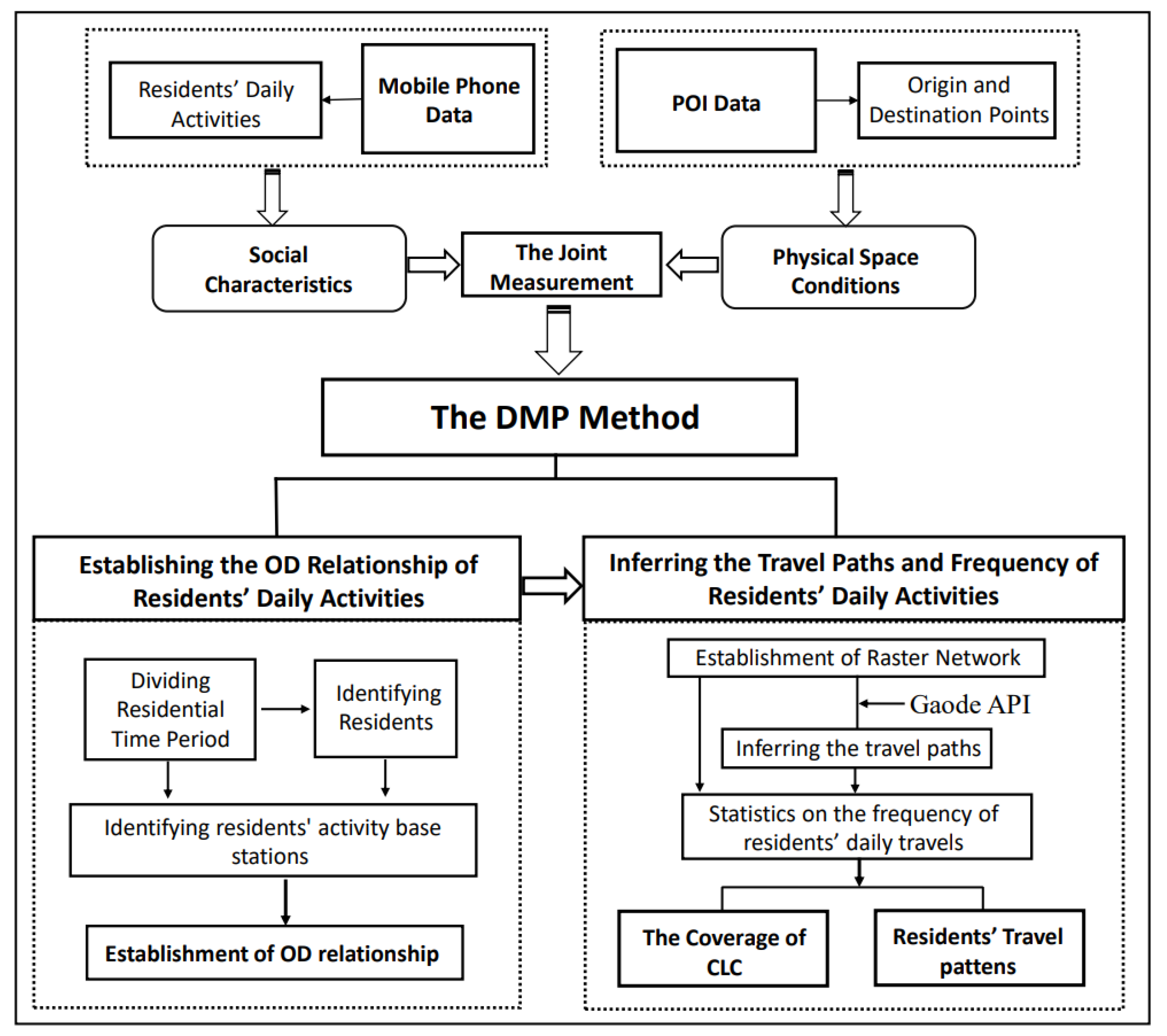
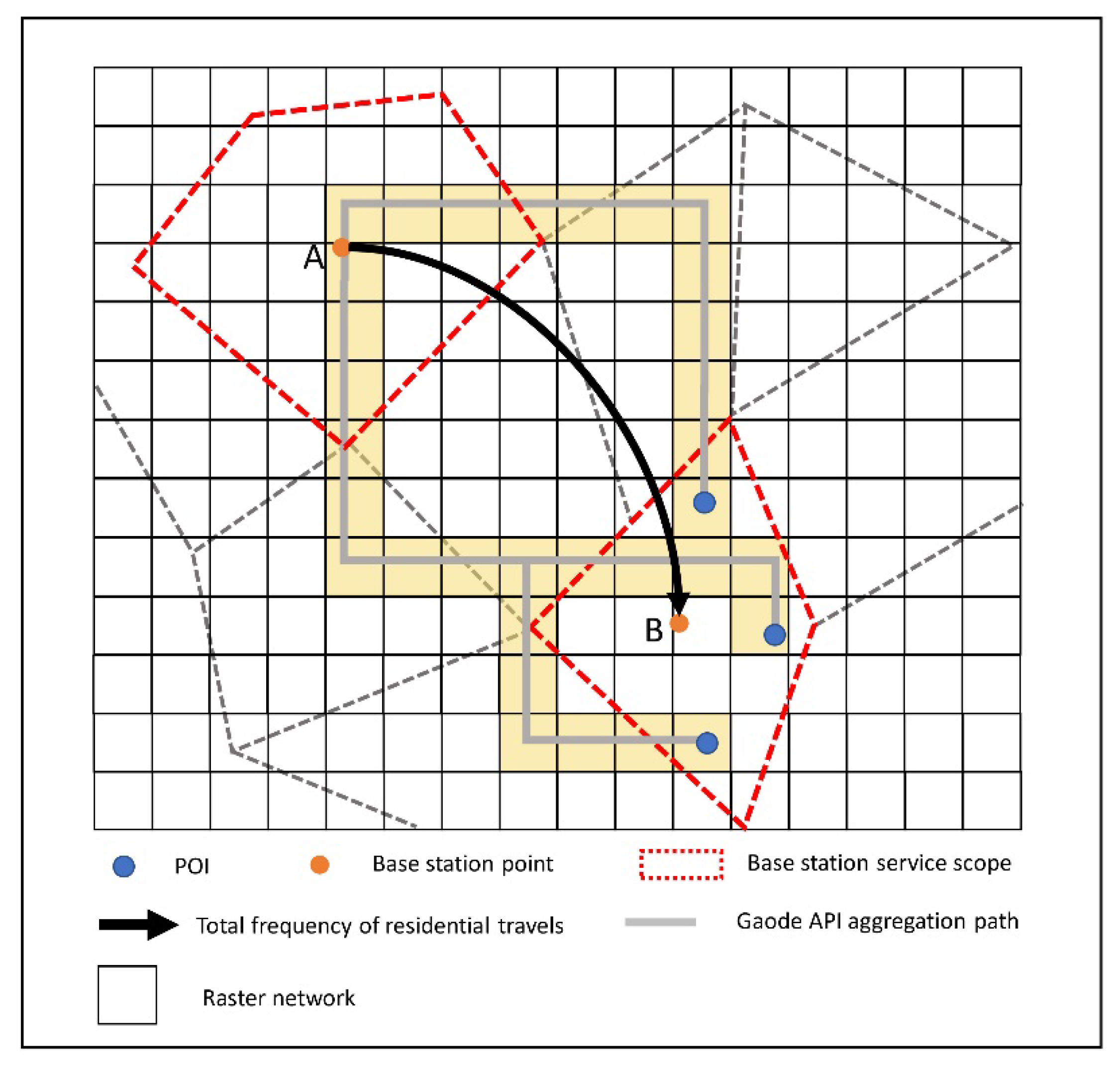
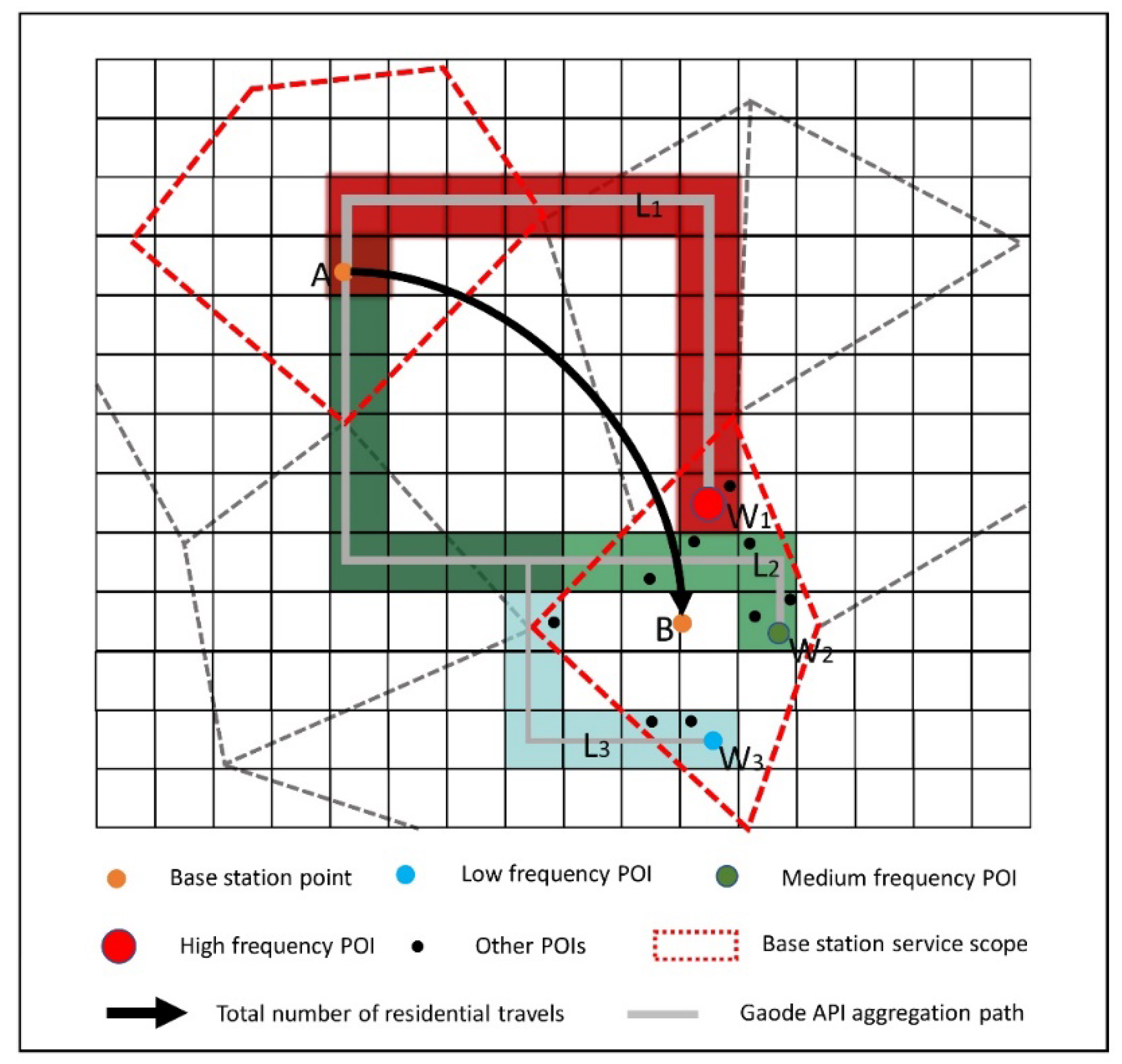


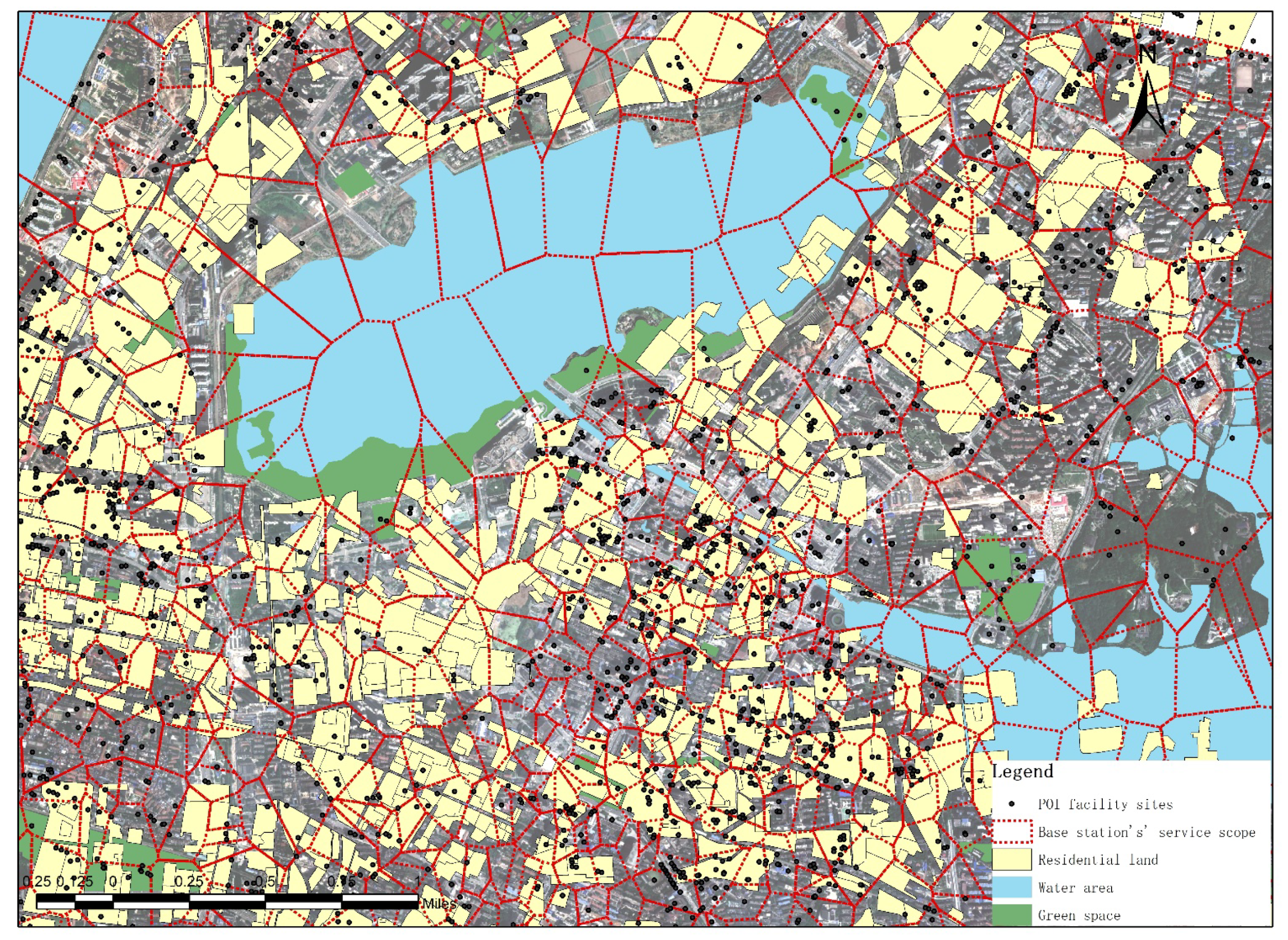
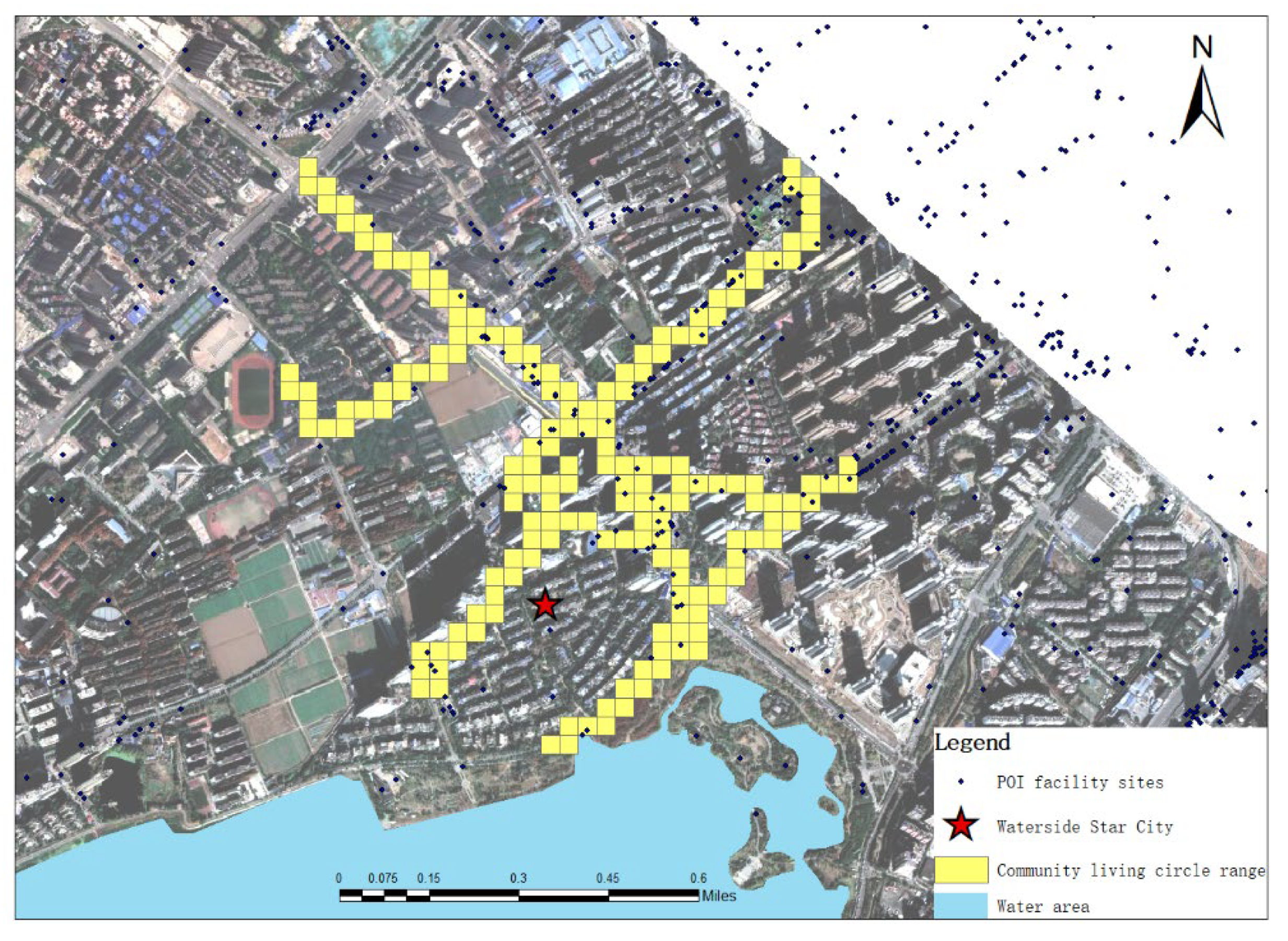

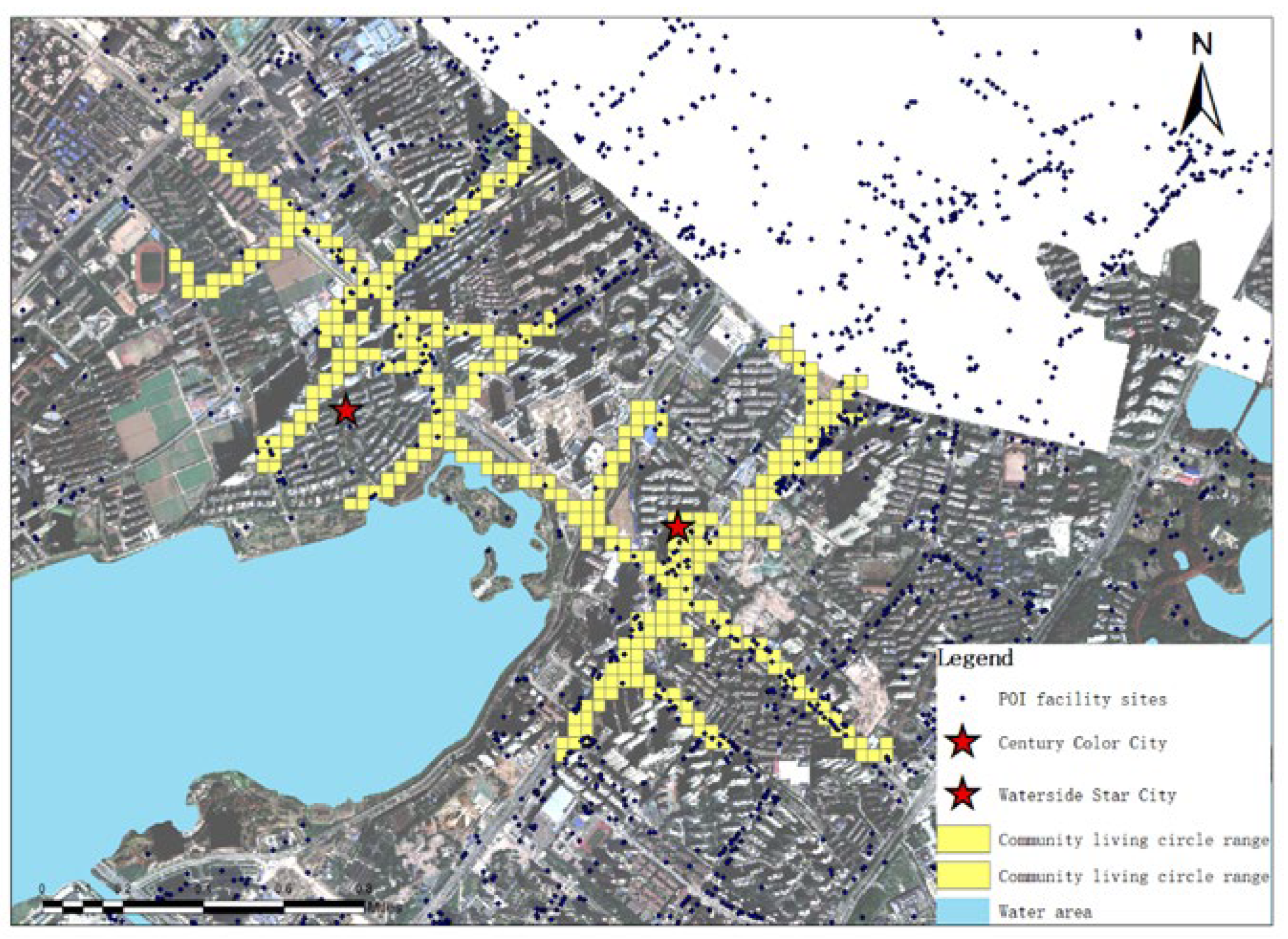
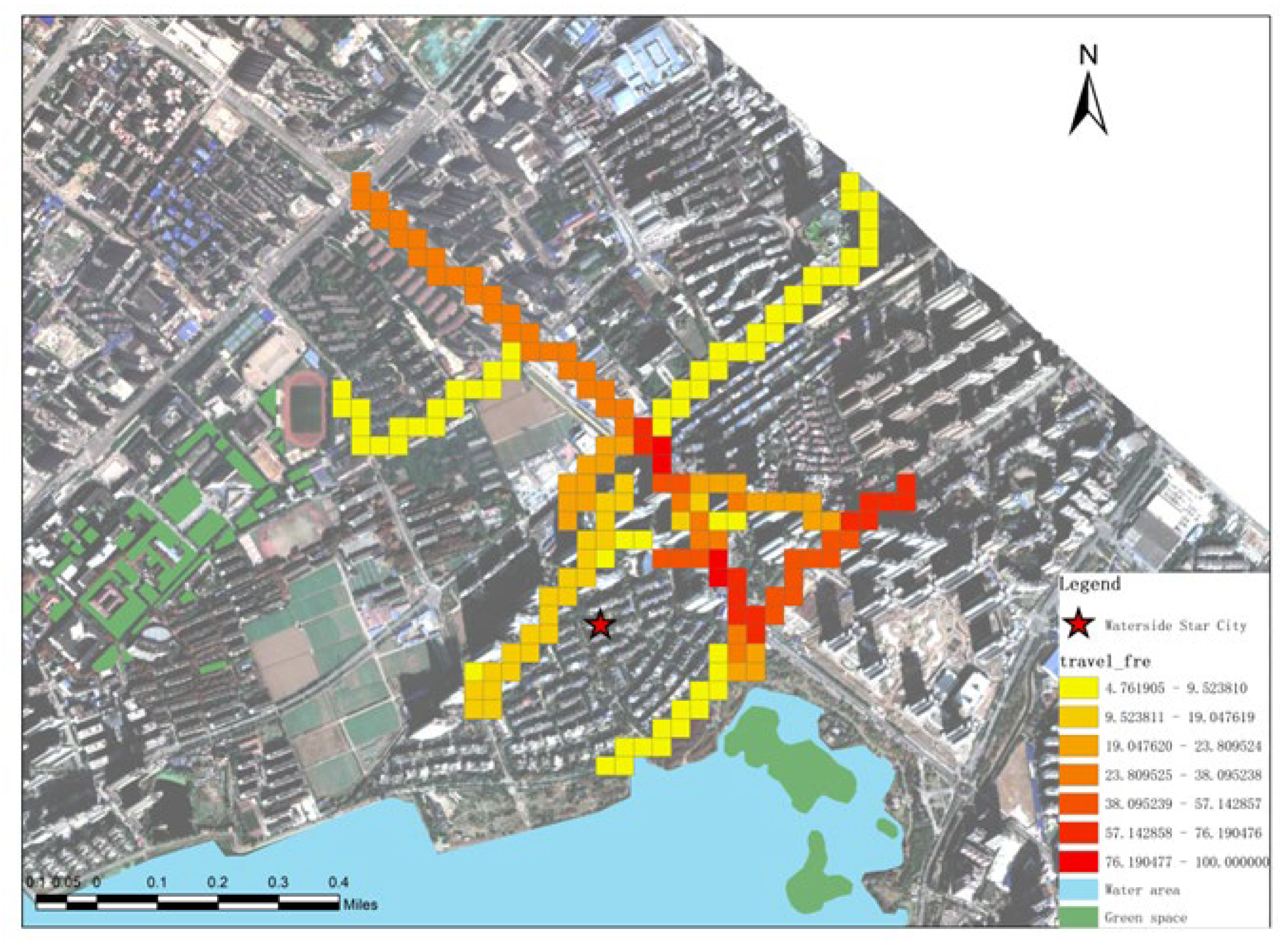
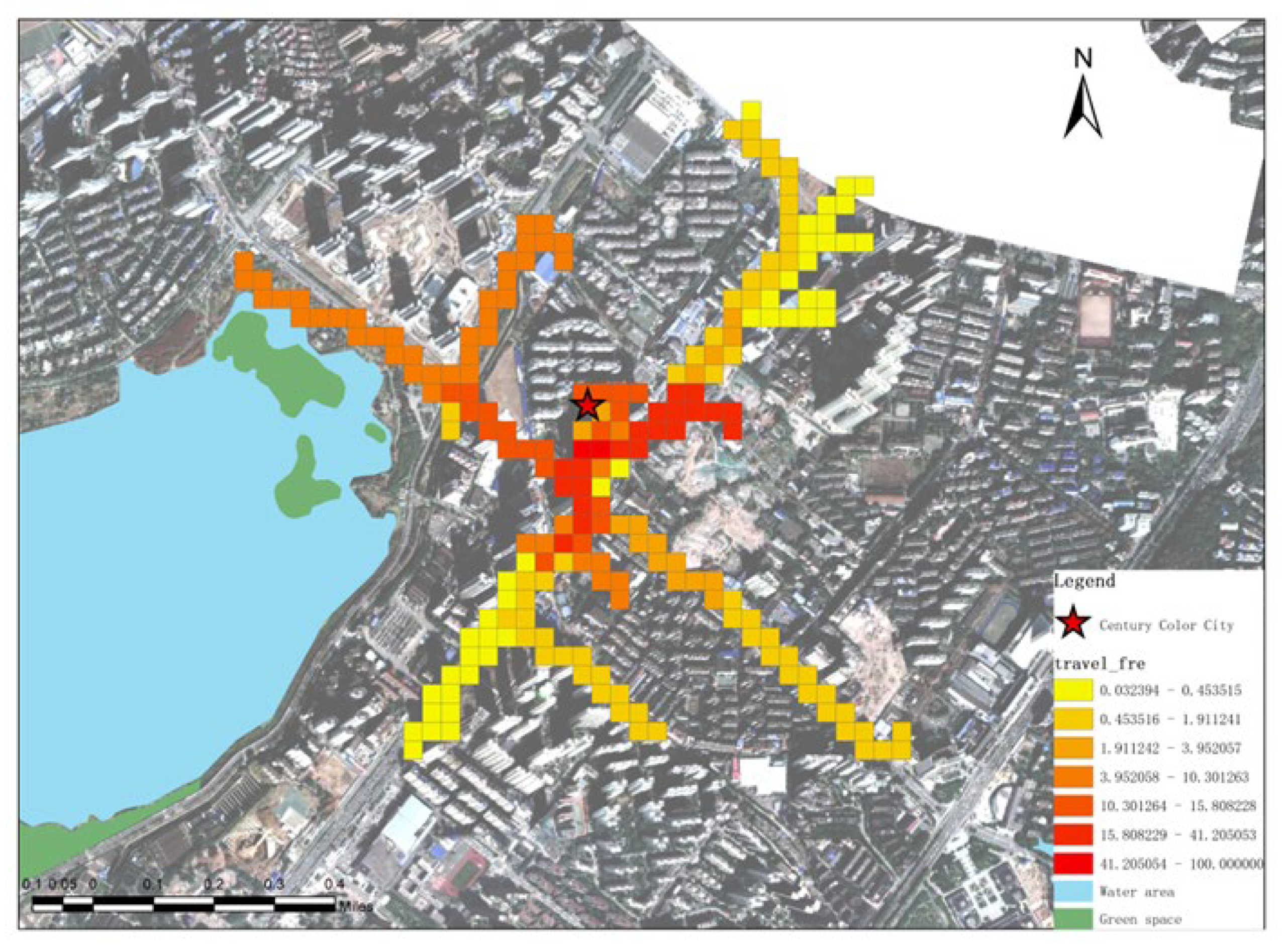
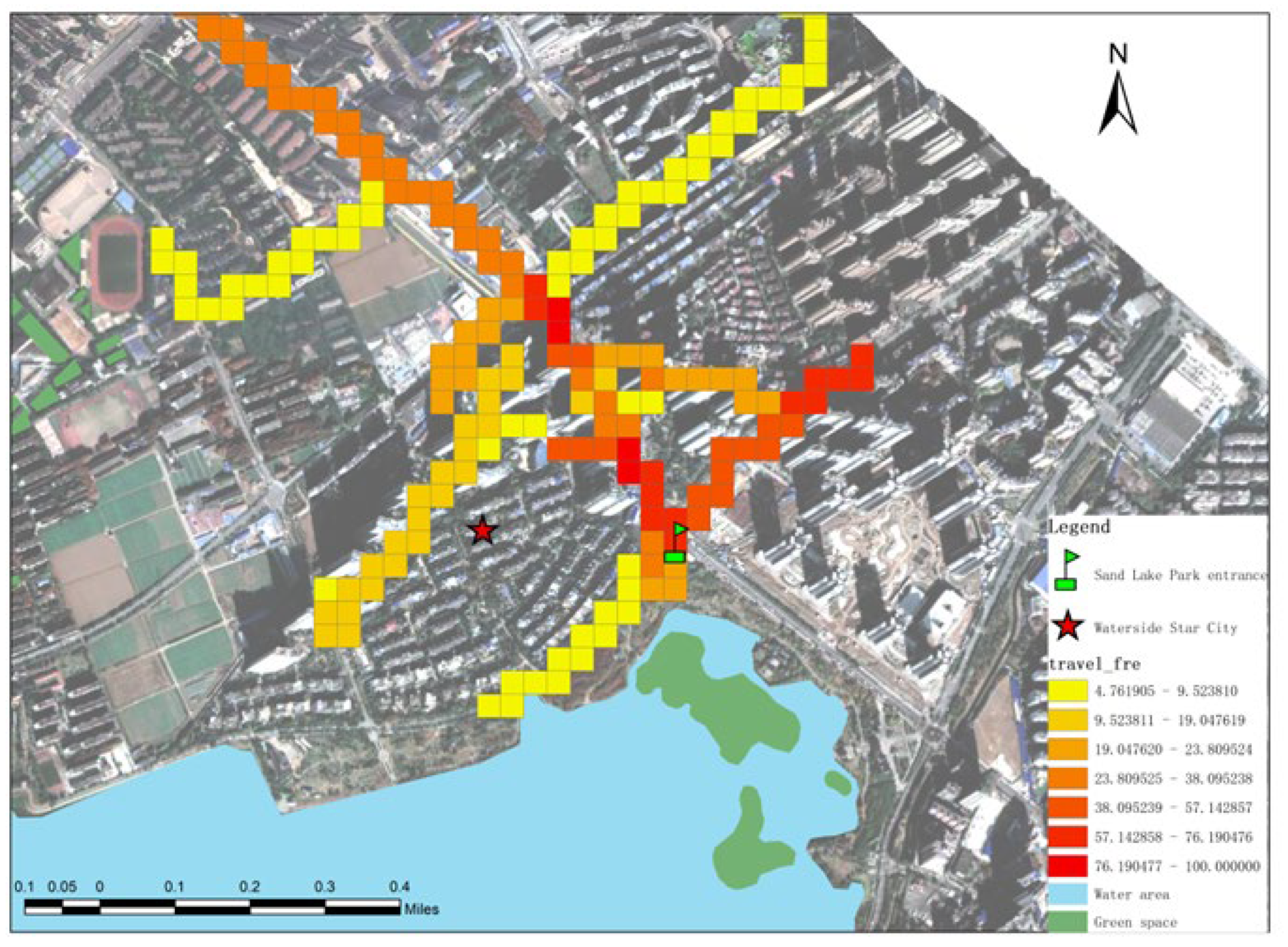
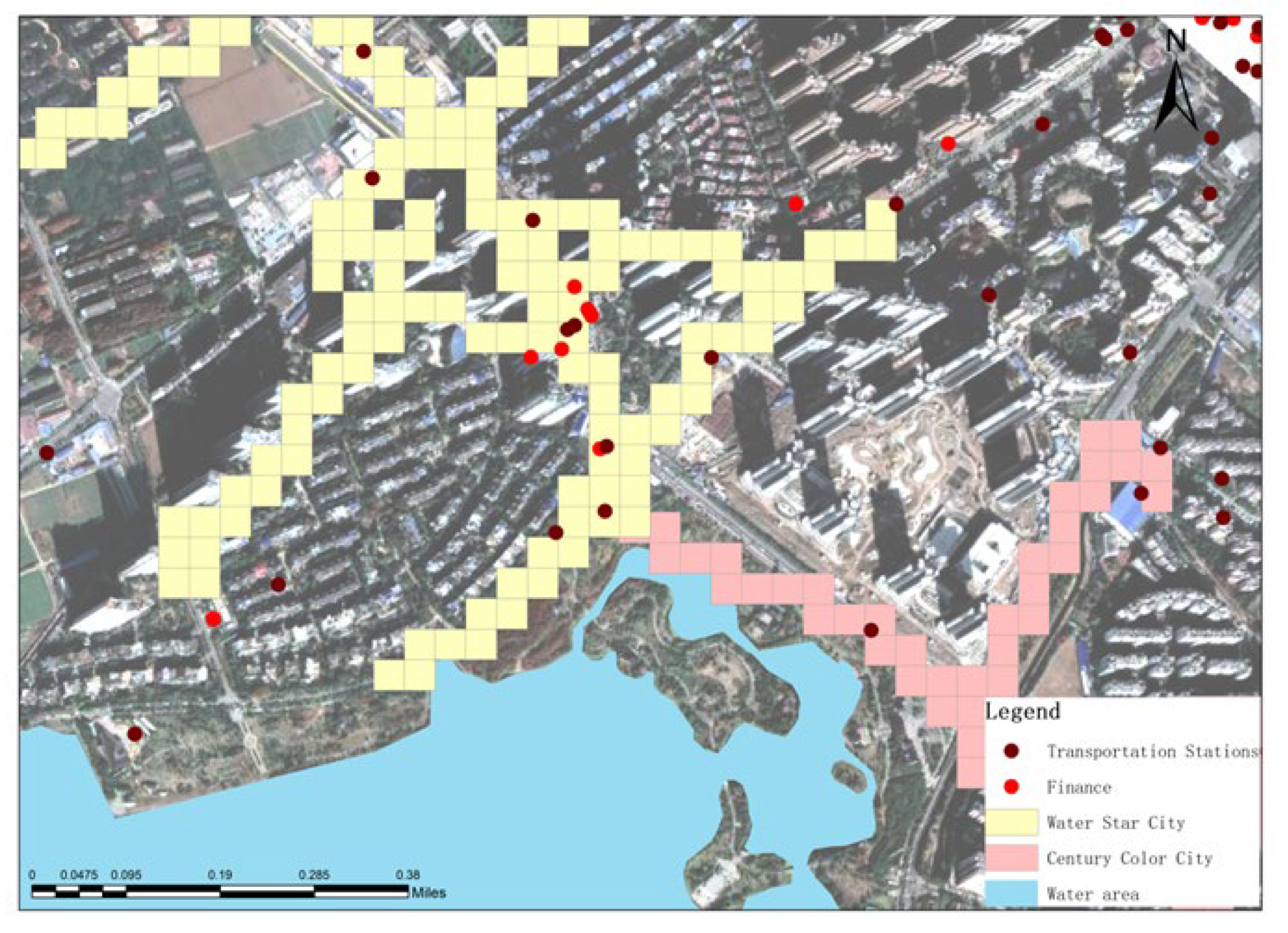
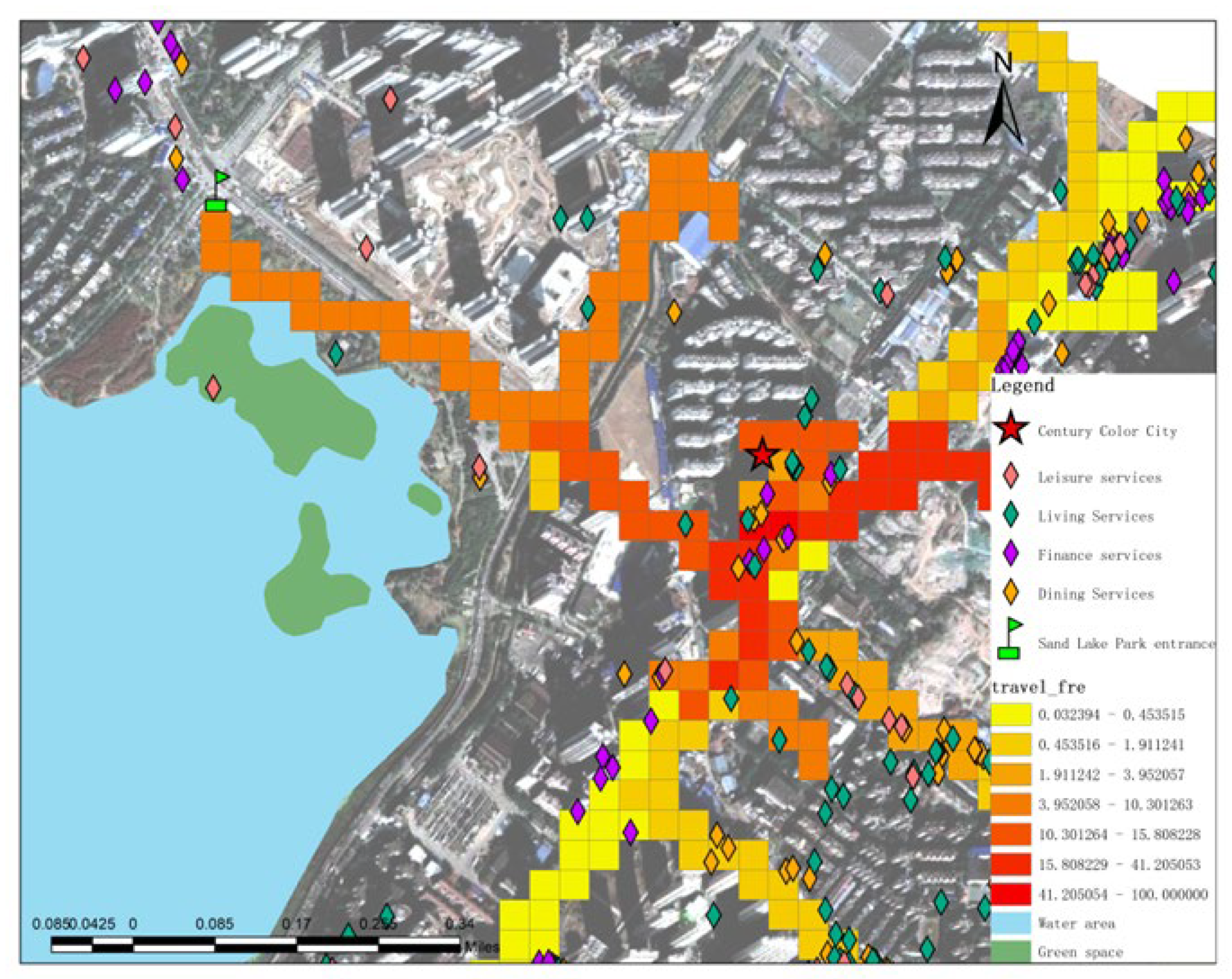
| Usage Frequency Class | High Frequency | Medium Frequency | Low Frequency |
|---|---|---|---|
| Weight distribution | 3 | 2 | 1 |
| POI Categories | Secondary Categories | Weights |
|---|---|---|
| Medical Health | Hospitals | 1 |
| Clinics, Pharmacies | 2 | |
| Healthcare | 1 | |
| Life Services | Living Services | 3 |
| Dining Services | 3 | |
| Sports & Leisure | 2 | |
| Car Service | 1 | |
| Shopping services, shopping malls | 3 | |
| Shopping Center | 2 | |
| Science and Culture Services | Kindergarten, elementary school, etc. | 2 |
| Finance services | Banks | 2 |
| Financial and insurance companies | 1 | |
| Leisure and tourism | Leisure Services | 3 |
| Tourist Attractions | 2 | |
| Transportation Facilities | Bus Stops | 3 |
| Parking lots | 2 | |
| Public Administration Facilities | ----- | 1 |
| UESRID | Date | Time | LAC | CID |
|---|---|---|---|---|
| 159****2868 | 3 | 7:47:43 | 712D | 0E1E |
| 135****9517 | 3 | 10:35:16 | 708B | 63D1 |
| 150****6343 | 3 | 9:05:11 | 703D | 4598 |
| BaseID | lng | lat |
|---|---|---|
| 2894030548 | 114.2725 | 30.71609 |
| 2897142595 | 114.3048 | 30.64788 |
| 2919344562 | 114.2877 | 30.15406 |
| Original Categories | Original Secondary Categories | New Categories | New Secondary Categories | Number of POI |
|---|---|---|---|---|
| Medical | Pharmacy | Medical Health | Hospitals | 392 |
| Healthcare | Clinics, Pharmacies | 2306 | ||
| Clinics | Healthcare | 259 | ||
| General Hospital | —— | |||
| Life Services | Life Services | Life Services | Living Services | 1408 |
| Science and Culture Services | Dining Services | 1321 | ||
| Auto Service | —— | Sports & Leisure | 1110 | |
| Leisure and Entertainment | Living Services | Car Service | 737 | |
| Dining Services | Shopping services, shopping malls | 197 | ||
| Sports & Leisure | Shopping Center | 90 | ||
| Shopping Services | ---- | |||
| Dining | Dining Services | ---- | ||
| Shopping | Shopping Center | ---- | ||
| General Shopping Malls | Science and Culture Services | Kindergarten, elementary school, etc. | 1522 | |
| Finance | Financial and Insurance Services | Finance services | Banks | 924 |
| Corporate Enterprises | Financial and insurance companies | 1241 | ||
| Banks | ----- | |||
| Tourist Attractions | Park Square | Leisure and tourism | Leisure Services | 755 |
| Tourist Attractions | Tourist Attractions | 554 | ||
| Transportation Facilities | Bus Stops | Transportation Facilities | Bus Stops | 839 |
| Parking lots | Parking lots | 2517 | ||
| Government Agencies | ---- | Public Administration Facilities | ----- | 3149 |
Publisher’s Note: MDPI stays neutral with regard to jurisdictional claims in published maps and institutional affiliations. |
© 2022 by the authors. Licensee MDPI, Basel, Switzerland. This article is an open access article distributed under the terms and conditions of the Creative Commons Attribution (CC BY) license (https://creativecommons.org/licenses/by/4.0/).
Share and Cite
Jiao, H.; Xiao, M. Delineating Urban Community Life Circles for Large Chinese Cities Based on Mobile Phone Data and POI Data—The Case of Wuhan. ISPRS Int. J. Geo-Inf. 2022, 11, 548. https://doi.org/10.3390/ijgi11110548
Jiao H, Xiao M. Delineating Urban Community Life Circles for Large Chinese Cities Based on Mobile Phone Data and POI Data—The Case of Wuhan. ISPRS International Journal of Geo-Information. 2022; 11(11):548. https://doi.org/10.3390/ijgi11110548
Chicago/Turabian StyleJiao, Hongzan, and Miaomiao Xiao. 2022. "Delineating Urban Community Life Circles for Large Chinese Cities Based on Mobile Phone Data and POI Data—The Case of Wuhan" ISPRS International Journal of Geo-Information 11, no. 11: 548. https://doi.org/10.3390/ijgi11110548
APA StyleJiao, H., & Xiao, M. (2022). Delineating Urban Community Life Circles for Large Chinese Cities Based on Mobile Phone Data and POI Data—The Case of Wuhan. ISPRS International Journal of Geo-Information, 11(11), 548. https://doi.org/10.3390/ijgi11110548











